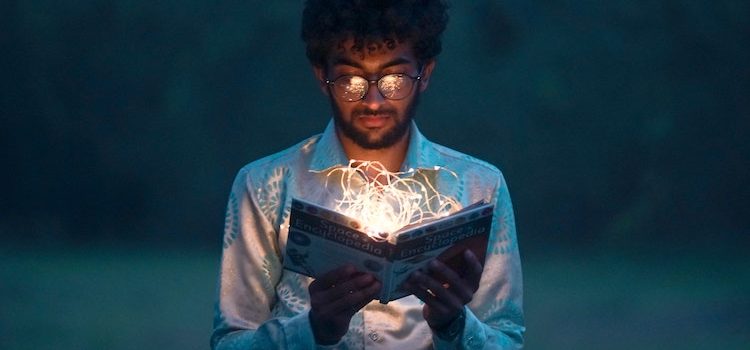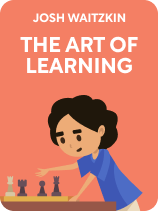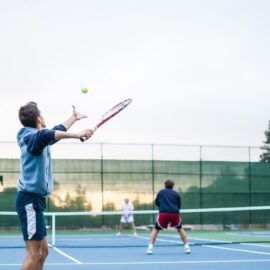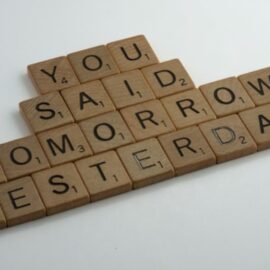

This article is an excerpt from the Shortform book guide to "The Art of Learning" by Josh Waitzkin. Shortform has the world's best summaries and analyses of books you should be reading.
Like this article? Sign up for a free trial here .
What is Josh Waitzkin’s The Art of Learning about? What is the essence of effective learning?
In his book The Art of Learning, Josh Waitzkin argues that effective learning comes from a resilient commitment to your growth process. His learning philosophy can be boiled down to three themes: 1) to always strive for “presence,” 2) to learn through trial and error, and 3) to balance tensions as you grow.
Let’s explore each theme in detail below.
Theme #1: Presence Is Central to Life and Learning
Waitzkin says that presence—which he defines as a deep, focused calm—is essential for the mastery of any skill. In competition, presence takes on a sharp, knife’s-edge quality—like the swordsman standing relaxed, yet intensely focused, when facing his opponent.
Presence, Waitzkin argues, underpins everything. The more present you are every day in every circumstance, the richer your life will become. Since presence features throughout The Art of Learning, we’ll first explore what presence means to Waitzkin.
In The Art of Learning, Josh Waitzkin gives two key reasons presence is important in life and competition:
Reason #1: Presence Equips You to Navigate the Turbulence of Life
The world is unpredictable. Distractions and discomfort, Waitzkin says, often crop up without warning. If you want to be great at anything, you have to learn to navigate these obstacles.
Presence—a calm, focused mind—helps you handle tension, whether it’s physical, mental, or emotional. Though Waitzkin doesn’t explain specifically how, he suggests that presence is a key tool for focusing in distracting environments and overcoming emotional discomfort.
For example, in soccer, a dishonest competitor might illegally trip you. It’s reasonable to get angry at such behavior, but that doesn’t help you perform. Instead, use presence to recenter and get back on track.
Reason #2: Presence Is the Key to Competitive Success
Being present helps you remain focused on the growth process and regain perspective when you lose. For example, Waitzkin recounts an early loss in his chess career that knocked him off balance. By separating himself from the game and being present within his life, he was able to return refreshed and reinspired.
At a high level, a competitor’s level of presence greatly affects their success. The margins are so slim at the top that deeper presence is a significant advantage—namely, because it helps you reach a flow state, or “the zone.” If you can reach the zone under competitive pressure and your opponent can’t, Waitzkin says, you’re going to win.
Competitive success at any level requires that you regulate your emotions and show up fully. Both of these depend on presence, which helps you calm emotional turbulence as well as reach and maintain focus. Waitzkin says when he lost presence in competition, opponents took advantage of his turbulent emotions and lack of focus.
Theme #2: Growth Comes From Trial and Error
Having discussed presence, we’ll now look at Waitzkin’s second key theme. Learning, he explains, happens through trial and error. You take one step at a time, sometimes succeeding, but often slipping up. When you make a mistake, you have an opportunity to grow.
For example, imagine you try to play a chord on a guitar. It doesn’t sound quite right, so you adjust your fingers and try again. Each time you do it incorrectly, the feedback tells you how to correct your form. Eventually, you’ll find the correct finger placement.
Each time you perform this trial and error cycle—act, err, adjust, repeat—you make an incremental improvement. In Waitzkin’s view, to learn is to build increment on increment on increment. Each addition builds your knowledge—in other words, the peak of success lies atop a mountain of mistakes.
This approach requires presence, which helps you grow through failure with patience, focus, and resilience. Presence helps you accept and act from the here and now. When you meet obstacles, a calm, focused state of being helps you face them head-on, accept internal and external turbulence, recover from falls, and stay oriented to your growth process.
Focus On the Process
To improve through trial and error, you need to have a growth mindset. Waitzkin explores Carol Dweck’s research on “incremental” versus “entity” theories of intelligence. In Mindset (Dweck’s book on the topic) she refers to these as “growth” and “fixed” mindsets. Here, we’ll examine Waitzkin’s interpretation of the two mindsets as they relate to skill building and competition.
With a growth mindset, you believe that you can develop your abilities through patient practice, building increment upon increment, and you see challenges as opportunities to stretch your current capacities.
Waitzkin argues that a growth mindset corresponds to focusing on the process. It’s about the overarching experience of learning, not any single point throughout it. Short-term goals test your progress, but they aren’t the ultimate point.
In contrast, people with a fixed mindset believe that ability is inherent and set in stone. Waitzkin warns that a fixed mindset is dangerous because it doesn’t prepare you for obstacles. Instead, people with fixed mindsets tend to give up when confronted with challenges that surpass their current abilities.
For example, a teenage football player with a fixed mindset will start to crack when he reaches the limits of his natural talent. When he can no longer win by talent alone, he’ll fall behind those who learn from their weaknesses.
A fixed mindset focuses on outcomes over process, Waitzkin says. So competitors with a fixed mindset worry about whether or not they’ll succeed, rather than focusing on what they can learn. When you inevitably face adversity, a fixed mindset gives you nothing to fall back on—your whole identity is built around winning, so you’ll collapse emotionally when you lose. This hampers growth, because growth comes from struggling at your limits.
Commit to Long-Term Effort
Because fixating on results makes you fragile, Waitzkin argues, winning is ultimately a weak incentive. It isn’t a reliable motivation, because you’ll inevitably lose at some point—becoming excellent requires it.
Waitzkin gives the example of a young chess player who was the best at his school. But at a chess conference, this boy refused to play against Waitzkin or anyone that he knew was better than him. According to Dweck’s mindset theory, this preserves the identity he’d built around being the local best by avoiding failure—and it exemplifies the fragility of fixating on results.
Rather than focusing on a desired outcome, Waitzkin recommends committing to the process of growth—to daily practice, focused patience, and adaptation in the face of obstacles. According to Waitzkin, this approach keeps you resilient, because you embrace failure as part of the journey instead of fearing it.
For example, he details how he lost repeatedly against the chess hustlers who set up in NYC parks, but took every loss as a learning experience. As the losses, thus lessons, accumulated, he improved his skills.
Balance the Process and Results
Results aren’t everything, but Waitzkin argues that they’re useful if you subordinate them to your growth process. In other words, set short-term goals, like medaling in an important competition, but think of them as tests—not the ultimate measure of your worth.
Testing yourself with short-term goals keeps you aware of your progress. Waitzkin explains that when you fail, that tells you that you need to work harder; and when you succeed, you can feel good about how far you’ve come.
For example, say you’re learning to speak Cantonese, and your goal is to chat with the cart pushers at your favorite dim sum spot. If you fall short the first time, that tells you to train harder. If you succeed, celebrate that win—then reorient to your process, and keep on training.
You need to win often enough to develop competitive confidence and lose often enough to avoid becoming overconfident. Overconfidence, Waitzkin says, causes arrogance, and arrogance makes you prone to mistakes. You forget that you’re fallible, and eventually someone will exploit that weakness and knock you down.
Waitzkin recommends that you regularly put yourself on the line in order to understand the stakes of competition and develop balanced confidence. At the same time, seek to learn whether you win or lose, treating each goal as a leg of your overarching journey.
Theme #3: Growth Requires Balancing Tensions
Waitzkin holds that learning is a process of balancing tensions. There are no clean, sharp lines that indicate what to do, where to stop, and so on. Rather, growth is a gray area that requires you to navigate fuzzy, nebulous experiences. For example, your body gives no obvious indication of when you’ve reached your mental limits, so you have to learn to sense when that edge is near.
Tension #1: Exertion and Relaxation
Properly managing how you stretch your limits, and how you recover, is one key to sustainable growth. Stretch far enough that you’ll expand your limit, but not so far that you hurt yourself mentally or physically.
For example, you have to learn your muscular limits when exercising. You can easily push too far, or not far enough—the key is to find an “optimal tension” somewhere in the middle, and maintain it as best as you can.
On the micro-level, effective cycling of effort and rest is key to building muscles and minds. Think of burnout—if you work nonstop, you’ll eventually crash, so it’s essential to rest at intervals in your workflow.
On the macro-level, Waitzkin argues that all competitors go through periods of toughness and periods of softness. Being present to those periods helps you maintain self-compassion and grow at a healthy pace. For example, athletes need both the off-season and a regular competitive schedule to stay fit and healthy.
Tension #2: Process and Results
As we explained in Theme #2: Growth Comes From Trial and Error, you need a long-term, process-oriented mindset to grow effectively. At the same time, Waitzkin says to use results to understand how you measure up, while remembering that where you stand isn’t the whole point. Finding enjoyment in the process itself is a more sustainable focus.
For example, applying for your dream job will tell you whether you’re competitive. But what you do with the result—whether you get it or not—determines whether you’ll grow or regress.
Tension #3: The Technical and the Creative
Skills have two aspects, according to Waitzkin: the practical, technique-focused side, and the creative, emotional side. Becoming excellent requires that you develop both of these, attaining a solid technical foundation without letting technique override your passion for the skill.
For example, many independent filmmakers commit to expensive projects fueled by their passion for the medium. But you can’t just point a camera and yell “action;” you need to actually know what you’re doing. At the same time, don’t let prescriptive training methods—which tend to mold everyone to a single style—dampen your unique artistic spirit.

———End of Preview———
Like what you just read? Read the rest of the world's best book summary and analysis of Josh Waitzkin's "The Art of Learning" at Shortform .
Here's what you'll find in our full The Art of Learning summary :
- Life advice from chess prodigy and tai chi World Champion Josh Waitzkin
- Detailed looks at the psychological and technical sides of skill-building
- How to build any skill from the bottom-up






